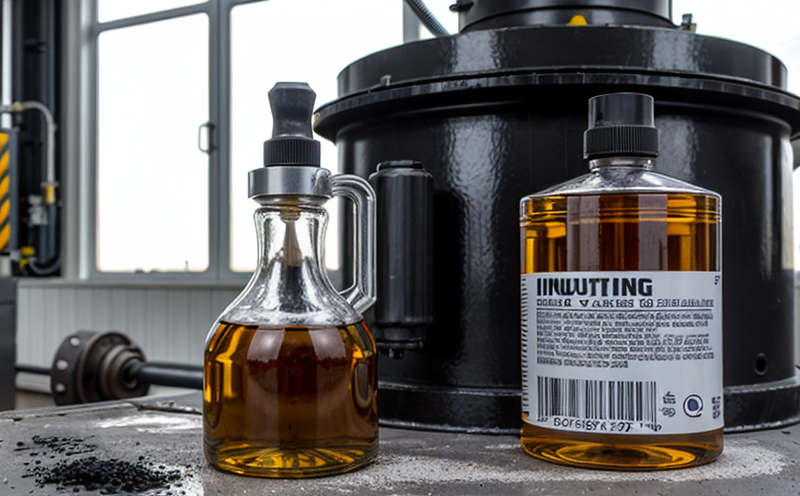ISO 2592 Flash Point Testing of Industrial Oils by Cleveland Method
The ISO 2592 standard for the determination of flash point by the Cleveland Open Cup method is widely recognized as an essential tool in chemical testing, particularly within the industrial oil and additive sector. This method provides a precise measurement that helps ensure product quality, safety, and compliance with industry standards.
The Cleveland Open Cup test involves heating a small quantity of petroleum or similar liquid fuel to a temperature at which it gives off sufficient vapor to form an ignitable mixture with air near the surface of the liquid. At this point, when exposed to a flame, the sample will ignite momentarily but not sustain combustion. This temperature is known as the flash point.
The primary purpose of determining the flash point using ISO 2592 is to assess the volatility and flammability characteristics of industrial oils. Understanding these properties is crucial for both safety and operational efficiency in various sectors, including manufacturing, aerospace, and automotive industries.
The test method requires strict adherence to specified procedures outlined in ISO 2592. These include specific apparatus, specimen preparation, and a controlled environment to ensure accurate results. The apparatus typically consists of the Cleveland Open Cup, a temperature measuring device, a suitable heating medium, and a flame source.
Specimen preparation involves ensuring the oil sample is representative of the batch being tested. This may require blending multiple samples if they are not homogeneous or filtering out any particulates that could affect test results.
The testing process itself involves carefully adding small amounts of the oil to the cup, maintaining a constant temperature rise rate, and observing for the flash ignition. The result provides valuable information about the fuel's safety margin against spontaneous combustion.
| Key Parameters | Description |
|---|---|
| Cleveland Open Cup | A glass or metal cup with a specific volume designed to hold the oil sample for testing. |
| Heating Medium | A suitable liquid that can be heated to maintain a consistent temperature during testing. |
| Flame Source | An electrically controlled flame used to ignite the vapor near the surface of the oil sample. |
The results from this test are critical for several reasons. They help in ensuring product safety, optimizing fuel efficiency, and meeting regulatory requirements. By accurately determining the flash point, manufacturers can identify potential hazards early on, preventing accidents and improving overall operational safety.
- Ensures compliance with international standards such as ISO 2592.
- Helps in the development of safer products by identifying potential risks associated with volatility.
- Supports efficient fuel management through better understanding of storage and handling conditions.
In conclusion, the ISO 2592 flash point test is a vital tool for assessing the safety and performance characteristics of industrial oils. Its application in various sectors underscores its importance in maintaining high standards of quality and compliance.
Scope and Methodology
| Scope | Description |
|---|---|
| Determination of flash point by the Cleveland Open Cup method. | This involves heating a small quantity of petroleum or similar liquid fuel to a temperature at which it gives off sufficient vapor to form an ignitable mixture with air near the surface of the liquid. At this point, when exposed to a flame, the sample will ignite momentarily but not sustain combustion. |
| Application in industrial oils and additives. | The test is particularly relevant for ensuring product safety and compliance within various sectors including manufacturing, aerospace, and automotive industries. |
The methodology closely follows ISO 2592 guidelines. It requires the use of a Cleveland Open Cup, a suitable heating medium, temperature measuring device, and an electrically controlled flame source. Specimen preparation involves ensuring the oil sample is representative and free from particulates.
Testing procedures include carefully adding small amounts of the oil to the cup, maintaining a constant temperature rise rate, and observing for the flash ignition. The result provides valuable information about the fuel's safety margin against spontaneous combustion.
Benefits
- Enhanced Safety: Accurate determination of flash point helps in identifying potential risks associated with volatility, ensuring safer storage and handling conditions.
- Regulatory Compliance: Ensures adherence to international standards such as ISO 2592, which is crucial for quality assurance and compliance.
- Better Fuel Efficiency: Understanding the flash point aids in optimizing fuel usage by providing insights into optimal storage and handling conditions.
- Product Quality Assurance: The test helps manufacturers identify potential issues early on, improving overall product reliability and performance.
The ISO 2592 flash point test is a cornerstone of quality assurance in the industrial oil sector. It ensures that products meet stringent safety standards while also providing critical data for ongoing research and development efforts.
Use Cases and Application Examples
| Use Case | Description |
|---|---|
| Manufacturing Industry: | Ensures that industrial oils used in machinery meet safety standards, thereby preventing accidents and maintenance issues. |
| Aerospace Sector: | Guarantees the safe handling of fuels during aircraft refueling operations, reducing fire hazards. |
| Automotive Industry: | Ensures that lubricants used in vehicles have appropriate flash points to prevent spontaneous combustion and related risks. |
For quality managers, compliance officers, R&D engineers, and procurement teams involved in these industries, the ISO 2592 flash point test is indispensable. It provides critical data that can be used to enhance product safety, optimize operational efficiency, and ensure regulatory compliance.
- Manufacturing: Ensures machinery operates safely by preventing the risk of fires due to volatile industrial oils.
- Aerospace: Reduces fire risks during refueling operations through proper fuel handling practices.
- Automotive: Enhances vehicle safety by ensuring lubricants have appropriate flash points, thus preventing spontaneous combustion.
The ISO 2592 flash point test is a vital tool for assessing the safety and performance characteristics of industrial oils. Its application in various sectors underscores its importance in maintaining high standards of quality and compliance.





